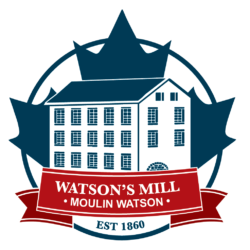After the death of Moss Kent Dickinson his sons, George and William, ran what was left of the milling complex. In the early 1900’s the complex consisted of the flour mill (Watson’s Mill) and the bung, plug, and spile mill. The Dickinson siblings, George, William, Charlotte, and Elizabeth, lived together in the house their father built in Manotick across from the flour mill. None of them ever married and there were no descendants.
As Dickinson’s children grew older, they pursued other ventures and were looking towards their retirement.
Then in steps Alexander Spratt…
AleXander Spratt

Alexander Spratt came from a local farming family, but left the family farm to move into Manotick. He was well known and liked in the community having established a successful business distributing flour and grain to local farmers, as well as bakeries in the City of Ottawa.
Spratt began leasing the Manotick mills from the Dickinson Family in 1923. The bung, plug, and spile mill would remain in operation until 1926. The building was then sold and removed from its foundations. Spratt purchased the flour mill in 1928 and in 1931, agreed to purchase the Dickinson’s Manotick home from Elizabeth, the last surviving child of Moss Kent Dickinson. The purchase of the home included the carriage sheds. Unverified documents state that at the time the carriage shed contained several teams of horses and the village fire truck .

While owning the flour mill Spratt diversified its operations. They continued to grind flour with Spratt also dealing animal feed, seed corn, coal, cement, and salt.
Spratt was deeply involved in the community and the Knox Presbyterian Church. During the winter, he maintained a public skating rink in the square, and in the summer, an unofficial baseball diamond for the local children.


Spratt died in 1935 after a battle with brain cancer. His wife, Cynthia, and family continued to operate the mill after his death renaming the mill the “Market Feed Store”. The Spratt Family improved the services at the mill by installing an animal feed mixer on the second floor in 1938, as well as a seed cleaner and animal feed grinder on the main floor in 1939.
The Spratt family leased the mill to Gordon Ferris from 1938 – 1943 while the Spratt children were away serving in the Second World War. Those who worked in the mill during this time kept track of the major events shaping the war and their lives on the interior frame of the main door.
After the end of the Second World War the Spratt Family sold the mill to one of their labourers and later mill managers.
In steps Harry Watson…
Harry Watson

From a young age Harry Watson was a ward of the Church of England, and was a part of the “”Bernado Boys” an orphanage system in England which brought older children to Canada as farm labourers.
In 1924, at the age of 16, Watson arrived from England on the Megantic. He was settled in Manotick Station and assigned to Mr. Tomkins the Station Master at Manotick Station. Watson would later work for Alex Spratt as a labourer and would manage the flour mill for the Spratt Family following Alex’s death. Watson also lived with the Spratt’s as one of the family.
Watson married Mr. Tomkins’ daughter, Anna, in 1930. They had five sons, Ron, Bill, Jack, Jim, Bob and one daughter, Mary. All were active in the operations of the mill over the years.

Watson purchased the mill from the Spratt Family in 1946. One of his first acts as owner was to re-christen the building “Watson’s Mill.” A sign baring this name was erected over the front door of the mill where it remains to this day.
The Spratt Family continued to live in the house across from the mill until 1948 when it was also purchased by Watson for his family.
Watson continued to operate the mill in much the same way as the Spratt Family. He also added new elements to the business by becoming an International Harvester tractor dealer, as well as selling items through their catalogue. He also delivered fuel oil and had a trucking business.






In 1956 the control dam that powered Watson’s Mill was totally rebuilt in concrete.
Under Watson’s ownership the Mill celebrated 100 years of operation in 1960, but by 1963 commercial flour grinding stopped at Watson’s Mill.
The building was about to take on a new life…

